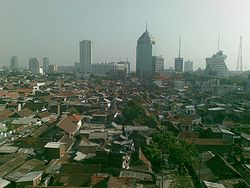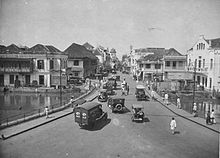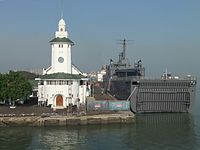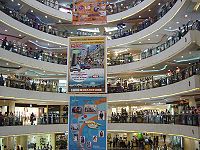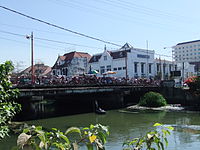- Surabaya
-
This article is about the Indonesian city. For the Dutch warship, see HNLMS De Zeven Provinciën (1909).
Surabaya
Suroboyo
SealMotto: Sparkling Surabaya, Heroes' City Location of Surabaya in Indonesia Coordinates: 7°15′55″S 112°44′33″E / 7.26528°S 112.7425°ECoordinates: 7°15′55″S 112°44′33″E / 7.26528°S 112.7425°E Country Indonesia Province East Java Settled May 31, 1293 Government – Mayor Tri Rismaharini – Vice Mayor Bambang Dwi Hartono Area – City 374.78 km2 (144.7 sq mi) – Metro 1,805.08 km2 (696.9 sq mi) Elevation 5 m (16 ft) Population (2010 Indonesia Census) – City 2,765,908 – Density 7,380.1/km2 (19,114.3/sq mi) – Metro 5,622,259 – Metro density 3,114.7/km2 (8,067/sq mi) Time zone WIB (UTC+7) Website surabaya.go.id Surabaya (pronounced [surəˈbaja]) (formerly Soerabaia or Surabaja) is Indonesia's second-largest city with a population of over 2.7 million (5.6 million in the metropolitan area), and the capital of the province of East Java. It is located on the northern shore of eastern Java at the mouth of the Mas River and along the edge of the Madura Strait.
To Indonesians, it is known as "the city of heroes" due to the importance of the Battle of Surabaya in galvanizing Indonesian and international support for Indonesian independence during the Indonesian National Revolution.
Contents
Etymology
Surabaya is locally believed to derive its name from the words sura or suro (shark) and baya or boyo (crocodile), two creatures which, in a local myth, fought each other in order to gain the title of "the strongest and most powerful animal" in the area according to a Jayabaya prophecy. This prophecy tells of a fight between a giant white shark and a giant white crocodile, which sometimes interpreted as a conflict between Mongol forces and Raden Wijaya's Majapahit forces. Now the two animals are used as the city's logo, the two facing each other while circling, as depicted in a statue appropriately located near the entrance to the city zoo. This folk etymology, though embraced enthusiastically by city leaders, is unverifiable.
Alternate derivations proliferate: from the Javanese sura ing baya, meaning "bravely facing danger"; or from the use of surya to refer to the sun. Some people consider this Jayabaya prophecy as a great war between Surabaya native people and invaders in 1945, while another story is about two heroes that fought each other in order to be the king of the city. The two heroes were Sura and Baya.
History
The earliest record of Surabaya was in a 1225 book written by Chau Ju-Kua, in which it was called Jung-ya-lu,[1] the ancient name of Surabaya. Ma Huan documented the early fifteen-century visit of Zheng He's Treasure ship in his 1433 book Ying-yai Sheng-lan: "after traveling south for more than twenty li, the ship reached Sulumayi, whose foreign name is Surabaya. At the estuary, the outflowing water is fresh".[2]
In the fifteenth and sixteenth centuries, Surabaya was a sultanate and a major political and military power in eastern Java. It entered a conflict with, and was later captured by, the more powerful Sultanate of Mataram in 1625 under Sultan Agung. It was one of Mataram's fiercest campaigns, in which they had to conquer Surabaya's allies, Sukadana and Madura and to lay siege to the city before capturing it. With this conquest, Mataram then controlled almost the whole of Java, with the exception of the Sultanate of Banten and the Dutch settlement of Batavia.
The expanding East Indies Companies took the city over from a weakened Mataram in November 1743. Surabaya became a major trading center under the Dutch colonial government, and hosted the largest naval base in the colony. In 1917, a revolt occurred among the soldiers and sailors of Surabaya, led by the Indies Social Democratic Association. The revolt was firmly crushed and the insurgents given harsh sentences.
Japan occupied the city in 1942 as part of the occupation of Indonesia, and it was bombed by the Allies in 1944. After that it was seized by Indonesian nationalists. However, the young nation was soon put into conflict with the British, who were caretakers of the Dutch colony after the surrender of the Japanese.
The Battle of Surabaya was one of the most important battles of the Indonesian revolution. It was started after British Brigadier Mallaby was killed on October 30, 1945 near Jembatan Merah (the "Red Bridge"), allegedly by a stray bullet. The Allies gave an ultimatum to the Indonesian freedom fighters inside the city to surrender, but this was refused. The ensuing battle, which took thousands of lives, took place on November 10, and is nowadays celebrated as Heroes' Day (Hari Pahlawan). The incident of the red-white flag (the Dutch national red-white-and-blue flag at the top of Yamato Hotel's tower that was torn into the Indonesian red-white flag) by Bung Tomo is also recorded as a heroic feat during the struggle of this city.
The City
As the main seaport and commercial center in the eastern region of Indonesia, Surabaya has become one of the largest cities in Southeast Asia. Today, Surabaya's population is around three million, and the surrounding rural area houses at least 7 million. The areas surrounding Surabaya include Lamongan to the northwest, Gresik to the west, Bangkalan to the northeast, Sidoarjo to the south, and Mojokerto and Jombang to the southwest. Gresik, Bangkalan, Mojokerto, Surabaya, Sidoarjo and Lamongan as an area is called as Gerbang Kertosusila.
On Wednesday, 10 June 2009 the Suramadu Bridge between Surabaya and the island of Madura; was completed and it is currently the longest bridge in the country. Madura can also be accessed by a ferry service that operates regularly from Surabaya's port, Tanjung Perak (which literally means: "Silver Cape" in Indonesian).
The Adhiwangsa, Taman Beverly, and Water Place Residences are three of the tallest skyscrapers in Surabaya.
Plaza Tunjungan, Galaxy Mall, Surabaya Plaza, Supermal Pakuwon Indah, Surabaya Town Square, and Royal Plaza Surabaya are the famous shopping center while Hi-Tech Mall, WTC, and Plasa Marina are the computers and mobile-phones shops center in Surabaya. Surabaya is home to the Eastern Armada, one of two in the Indonesian Navy. Its strong maritime heritage is also reflected with the Submarine Monument, a real retired Russian submarine, called Pasopati, that was converted into a museum ship in the city center. Flooding is common in many areas of the city during the rainy season, mostly caused by clogged sewers and inept bureaucracy. The fact that Surabaya is located in a river delta and has a flat and relatively low elevation doesn't help the matter either.
Surabaya is the location of the only synagogue in Indonesia, but it rarely obtains a minyan. There is also a Jewish cemetery in the city.[3][4]
Surabaya's zoo, opened in 1916, was the first in the world to have successfully bred orangutans in captivity. Other points of interest include:
- Grand Mosque of Surabaya, the largest mosque in East Java.
- Cheng Ho Mosque, the first mosque in Indonesia built with Chinese-style architecture
- Jales Veva Jaya Mahe Monument, a large, admiral-like statue which commemorates the Indonesian Navy.
- Mpu Tantular Museum, has a large collection of ancient Javanese artifacts.
- Monkasel, abbreviated from Monumen Kapal Selam (English: Submarine Monument) [1]
- A Soviet-built submarine display (named KRI Pasopati (410)), which proudly served in Indonesian Navy since 1962. Launched in 1952 and since her decommisioning in 1990, now preserved as a monument. It is open as tourism attraction. The body/hull was slightly cut for stairs & door for easier public entrance & viewing. Right beside the monument there is a building where a short movie about the history of the submarine itself can be watched.
- Bonbin Surabaya is one of the famous zoos in Southeast Asia, though it is as well known for its mistreatment of animals as it is its collection.[5] The situation reached a point in 2010 where the Jakarta Post called the facility the 'Surabaya Zoo of Death'.[6]
- Heroic Monument is the main symbol and one of the attractive tourist destinations in Surabaya and Southeast Asia
- House of Sampoerna is a cigarette museum, and also one of the factory of Sampoerna brand cigarette. It also provides a City Sightseeing bus for free (Surabaya Heritage Track) which operates daily with the particular schedule. It also provides an English tour guide for the sightseeing.
Surabaya has 31 subdistricts. They are: Genteng, Bubutan, Tegalsari, Simokerto, Tambaksari, Gubeng, Krembangan, Semampir, Pabean Cantikan, Wonokromo, Sawahan, Tandes, Karang Pilang, Wonocolo, Rungkut, Sukolilo, Kenjeran, Benowo, Lakarsantri, Mulyorejo, Tenggilis Mejoyo, Gunung Anyar, Jambangan, Gayungan, Wiyung, Dukuh Pakis, Asem Rowo, Sukomanunggal, Bulak, Pakal and Sambikerep.[7]
Surabaya contains three townships. In West Surabaya, Citraland by the Ciputra Group and Graha Family which consists of residences an apartment complex, a golf course and a climbing gym. East Surabaya, Pakuwon City by the Pakuwon Group. Pakuwon City has its own dining out spot, called Food Festival, and it is developing more facilities, such as the East Coast Center. Surabaya consists of 163 villages.[7]
In June 2011, Surabaya got the Adipura Kencana Award as number one among 20 cities in Indonesia. Surabaya today has many wide sidewalks and parks as a miniature of Singapore -being clean and green- said one reporter from Singapore.[8]
Climate
Surabaya features a tropical wet and dry climate, with distinct wet and dry seasons. The city's wet season runs from November through May, while the dry season covers the remaining five months. Unlike a number of cities and regions with a tropical wet and dry climate, average high and low temperatures are very consistent throughout the course of the year, with an average high temperature of around 31 degrees Celsius and average low temperatures of around 26 degrees Celsius. Surabaya on average sees approximately 1500 mm of precipitation annually.
Climate data for Surabaya Month Jan Feb Mar Apr May Jun Jul Aug Sep Oct Nov Dec Year Average high °C (°F) 30
(86)30
(86)31
(87)31
(88)31
(88)31
(87)31
(87)31
(88)32
(89)33
(91)32
(90)31
(88){{{year high C}}}
(88)Average low °C (°F) 25
(77)25
(77)25
(77)26
(79)26
(79)25
(77)24
(76)25
(77)25
(77)26
(79)26
(78)26
(78){{{year low C}}}
(78)Precipitation mm (inches) 280
(11.02)250
(9.84)230
(9.06)140
(5.51)100
(3.94)50
(1.97)20
(0.79)10
(0.39)10
(0.39)40
(1.57)120
(4.72)130
(5.12)1,470
(57.87)Source: .[9] Transport
The city is served by Juanda International Airport. For trains, the city has several stations. They are Surabaya Kota (better known as Semut), Pasar Turi, and Gubeng. The main bus terminal is Purabaya (also known as Bungurasih, the area where it is located).
Transportation in Surabaya is supported by the infrastructure of land transport, sea and air that could serve the local trip, regional, and international. The transport of the city is supported by public transport of the city transport, taxis, and the city bus. Surabaya is also a transit city between Jakarta and Bali for ground transportation. Many tourists go through the city of Surabaya for sightseeing before they go back to Jakarta or continue their journey to Bali. Another bus routes are between Jakarta and the neighboring island of Madura.
Tanjung Perak is the main port of the city and is one of the busiest ports in the country. Nowadays, it is also one of the top ten busiest cargo ports in Southeast Asia. Although the port is nearly traditionally administered, it is also used to carry modern cargo ships worldwide. The other port of the city is located in Gresik, a city which is located less than an hour drive from Surabaya city centre to Gresik via highway. In the future, Gresik will be the location for the new harbor and Tanjung Perak will be demolished and will be redeveloped as a recreation area for Surabaya.
Juanda International Airport is the second busiest airport in Indonesia in terms of transit passengers. Many passengers transit through the airport. It is famous as a transit airport between West and East Indonesia and it is also a hub airport of many airlines. In the future, the international airport activities will be removed to the new airport somewhere at Lamongan. However, domestic airport activities will remain at the old airport.
Suramadu Bridge
Suramadu Bridge currently the longest bridge in Indonesia
The Suramadu Bridge connects Surabaya and Madura Island over the Madura Strait. Suramadu is an abbreviation of Surabaya-Madura. A 16-kilometer highway will be built from the Suramadu Bridge to Madura International Seaport-City (MIS-C) in Pernajuh village, Kocah district, Bangkalan, Madura at a cost of approximately Rp60 billion ($7 million). This container port was built to ease the burden on Surabaya's overloaded [Tanjung Perak Port].[10]
Economy
The city is one of the busiest ports in the country. Its principal exports include sugar, tobacco and coffee. It has a large shipyard, and numerous specialized naval schools.
As the provincial capital, Surabaya is also home to many offices and business centres. Surabaya's economy is also influenced by the recent growth in foreign industries and the completion of the Suramadu bridge. Surabaya is currently in the process of building high rise skyscrapers such as apartments, condominiums, and hotels as a way of attracting foreign people to the city.
Surabaya is the main trading port in East Java. Enriched by its facilities, and geography advantages, Surabaya has great economic potential.
Demographics
Surabaya is the second most populous city in Indonesia, after Jakarta, with 2,765,908 recorded in the chartered city limits (kota) in 2010 census.[11] Like many other large Indonesian metropolises, many residents reside outside the city limits in a metropolitan area called Gerbangkertosusila. The city is highly urbanized, due to the many industries located in the city, resulting in many slum areas. As the main education center, Surabaya has been the home for many students from around Indonesia, thus they have created their own community.
Ethnicity
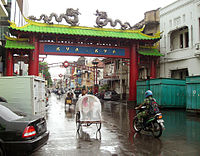 Kya-Kya Kembang Jepun, Chinatown in Surabaya.
Kya-Kya Kembang Jepun, Chinatown in Surabaya.
Surabaya is a multi-ethnic city: foreign nationalities represented include Malaysian, Chinese, Indian, Arab, and European. In addition to Javanese and Madurese natives, the city also has representatives of other Indonesian areas: Sunda, Minangkabau, Batak, Banjar, Balinese, and Bugis.
The majority of Surabaya citizens work in retail, whether in the expensive stores in the center city or the many small shops and stalls throughout the metropolis.
Surabaya is an old city that has expanded over time, and its population still grows at approximately 1.2% per year. In recent years, people have been moving from the crowded city center to suburban subdivisions featuring golf courses and strict security.
Language
Most citizens speak a dialect of Javanese called Suroboyoan. A stereotype of this dialect concerns its equality and directness in speech. The usage of register is less strict than the Central Javan dialect. The Surabaya dialect is actively promoted in local media, such as in local TV shows, radio and traditional dramas called Ludruk.
Time
In Indonesia, the keeping of standard time is divided into three time zones, Surabaya follow the Western Indonesian Time/WIT (Indonesian: Waktu Indonesia Barat/WIB) (UTC+7).
Religion
Most citizens in Surabaya adhere to Islam. Other religions include Christianity, Hinduism, Buddhism, Confucianism
- Islam
Islam is the main religion in Surabaya.[12]
- Orthodox Christianity
The city is also home to the Orthodox Christian Center Surabaya which was opened on 15 October 2008 by Father Yohanes Bambang Cahyo Wicaksono an Orthodox Priest.[13] The city is also home to two Orthodox Christian Community centres and there are plans to establish a kindergarten, High School and University in the medium term. The head Orthodox Church in Indonesia, St Nikolas is also based in Surabaya.[14] On the 12th of January a new Orthodox Orthodox Community center was opened in the Dinoyo district, beside St. Nikolaos Orthodox Church.[15]
- Roman Catholicism
The city is the home of the Roman Catholic Diocese of Surabaya.
- Graha Bethany Nginden
In 2000 Graha Bethany Nginden conducted a soft opening at the same time doubling the Church Seminar International (SPGI) 2000. This place can accommodate 20 000 members of the congregation.
Bethany Indonesian Church Synod, or Bethany is an incorporated church Synod of Indonesia and based in Surabaya. Bethany is one church with charismatic theology with a Pentecostal denomination. This church is a member of the Evangelical Fellowship of Indonesia (PII).
Bethany Indonesian Church, acknowledged, accepted, and set the Apostles' Creed as the Confession of Faith Church Bethany Indonesia.
Surabaya is also the base of one of Asia's largest Megachurches. Gereja Mawar Sharon is a non-denominational charismatic church with over 30 churches in Indonesia and over 40000 church goers every week. Gereja Mawar Sharon or Mawar Sharon Church has been holding major events in Surabaya such as Surabaya For Jesus, Asia For Jesus, Festival Kuasa Allah (Festival of God's Power) and many more. It has the largest Christian youth group of over 8000 weekly attendance. In Surabaya alone, Mawar Sharon Church have over 17000 church members
Dolly
Dolly is a brothel district in Surabaya known throughout Indonesia, with an estimated 2,000 prostitutes working there.[16] It is the largest lokalisasi (prostitution tolerance zone) in Indonesia,[17] and the largest red-light district in Southeast Asia,[18] and Islamic groups have campaigned to close it. In June 2011, the administration announced plans to decrease the commercial sex worker population from 1,132 to 750 by the end of 2012 by applying restricted hours instead of the current 24-hour operation.[19] Although it has been forced to move several times in history, Dolly is thought to have been originally founded by a Dutch madam, Dolly van der Mart.[20]
Education
Surabaya has several major universities and institutions with religious or technical specialties. Some of them are Universitas Airlangga (Airlangga University), Institut Teknologi Sepuluh Nopember Surabaya (Tenth of November Institute of Technology), Universitas Negeri Surabaya (State University of Surabaya), Institut Agama Islam Negeri Sunan Ampel.
Sister relationships
Surabaya has sister relationships with a number of towns worldwide:
- Seattle, United States, since 1992
- Beijing, China, since 2006
- Kōchi, Japan
- Mashhad, Iran
- Busan, South Korea
- Jeddah, Saudi Arabia
- Izmir, Turkey since 1996
- Guangzhou, China, since 2005
- Xiamen, China, since 2006
- Porto Alegre, Brazil since 2008
- Johor Bahru, Malaysia since 2008
- Fuzhou, China, since 2009
- Rotterdam, Netherlands
- Alexandria, Egypt
- Kuching, Malaysia
- Varna, Bulgaria
- Naples, Italy
References
- ^ F. Hirth and W.W.Rockhill, Chau Ju-kua, St Petersburg, 1911
- ^ Ma Huan Ying-yai Sheng-lan, The Overall Survey of Ocean Shore, translated by J.V.G Mills, P90, 1970 Hakklut Society, reprint by White Lotus, 1997 ISBN974-8496-78-3
- ^ The Synagogue of Surabaya, Indonesia
- ^ The Jews of Surabaya, by Jessica Champagne and Teuku Cut Mahmud Aziz.
- ^ "Gibbon Latest Victim as Surabaya Zoo Death Toll Continues to Climb". Bataviase. 25 September 2010. http://bataviase.co.id/node/347085.
- ^ "More Animals in Critical Condition at Surabaya’s Alleged Zoo of Death". Jakarta Post. 19 August 2010. http://www.thejakartaglobe.com/home/more-animals-in-critical-condition-at-surabayas-alleged-zoo-of-death/391758.
- ^ a b Surabaya City Regulation No. 5 2006
- ^ "Surabaya, a miniature of Singapore". September 5, 2011. http://www.thejakartapost.com/news/2011/09/05/surabaya-a-miniature-singapore.html.
- ^ Weatherbase: Historical Weather for Surabaya, Indonesia
- ^ http://www.thejakartapost.com/news/2011/04/28/surabaya’s-hotel-business-boom-‘likely-continue’.html
- ^ http://www.gatra.com/2010-08-25/artikel.php?id=140930
- ^ International Religious Freedom Report 2002
- ^ www.orthodox.or.id
- ^ Orthodox Indonesia Church Parokia St. Nikolaos
- ^ New Orthodox Community in Indonesia
- ^ Hello Dolly! – In Praise of Lokalisasi
- ^ Taufiq, Fatkhur Rohman (2010-10-26). "NU Jatim Setuju Gang Dolly Ditutup". Tempointeraktif.Com. http://www.tempointeraktif.com/hg/surabaya/2010/10/26/brk,20101026-287220,id.html.
- ^ "Surabaya, tourism and the Dolly". The Jakarta Post. 2001-05-30. http://www.thejakartapost.com/news/2001/05/30/surabaya-tourism-and-dolly.html.Sirikit Syah and Riyadi Ngasiran
- ^ http://www.thejakartapost.com/news/2011/06/04/dolly-red-light’s-hours-restricted.html
- ^ "Tis Not the Season to Be Dolly". Jakarta Globe. 2010-08-10. http://www.thejakartaglobe.com/news/tis-not-the-season-to-be-dolly/390408.
External links
Regencies and cities of East Java (Jawa Timur) Capital: SurabayaRegencies
Banyuwangi • Bangkalan • Blitar • Bojonegoro • Bondowoso • Gresik • Jember • Jombang • Kediri • Lamongan • Lumajang • Madiun • Magetan • Malang • Mojokerto • Nganjuk • Ngawi • Pacitan • Pamekasan • Pasuruan • Ponorogo • Probolinggo • Sampang • Sidoarjo • Situbondo • Sumenep • Trenggalek • Tuban • Tulungagung

Cities
Wikimedia Foundation. 2010.

